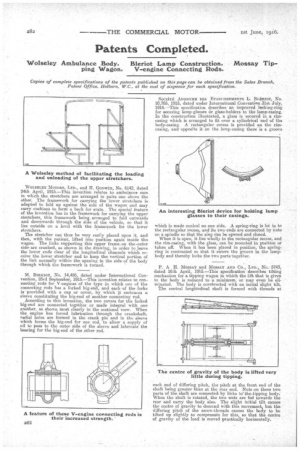Patents Completed.
Page 20

If you've noticed an error in this article please click here to report it so we can fix it.
Virolseley Ambulance Body. Bleriot Lamp Construction. Mossay Tipping Wagon. V-engine Connecting Rods.
Copies of complete specifications of the patents published on this page can be obtained from the Sales Branch, Patent Office, Holborn, WO., at the cost of sbeixnce for each specification.
WOLSELEY MOTORS, Mtn., and H. GODWIN, No. 6142, dated 24th April, 1915.—This invention rela,tes to ambulance cars in which, the stretchers are arranged in pairs one above the other. The framework for carrying the lower stretchers is adapted to fold up against the side of the wagon and may carry cushions to form a back for seats. The special feature of the invention lies in the framework for carrying the upper stretchers, this framework being. arranged to fold outwards and downwards through the side of the vehicle, so that it lies outside on a level with the framework for the lower stretchers.
The stretcher can thus be very easily placed upon it, and then, with the patient, lifted into position again inside the wagon. The links supporting this upper frame .on the-outer sido are cranked, as shown in the drawing, in order to leave the lower ends clear of the longitudinal channels which receive the lower stretcher and to keep the vertical portion of the link normally within the opening in the side,of the body through which the framework is turned.
M. BIRRIGT, No. 14,426, dated under International Convention, 23rd September, 1915.—This invention relates to connecting rods for V-engines of the type in which one of the connecting rode has a forked big-end, and each .of the forks is 'provided with a cap or cover, by which it embraces a sleeve constituting the big-end of another connecting rod.
According to this invention, the two covers for the forked big-end are connected together or made integral with one another, as shown most clearly in the sectional view. When the engine has forced lubrication through the crankshaft, radial holes are formed in the crank pin and in the sleeve which forms the big-end for one rod, to allow a supply of oil to pass to the outer side of the sleeve and lubricate the bearing for the big-end of the other rod. SOCIETE ANONYMD DES ETABLISSEMENTS L. BLARIOT, No. 10,765, 1915, dated under International Conventien 31st July, 1914. --This specification describes an improved locking-ring for securing lamp-glasses e'r glass-holders to the lamp-casing. In the construction illustrated, a glass is secured in a rimcasing which is arranged to fit over a cylindrical end of the body-casing. A rectangular recess is provided on the rimcasing, and opposite it on the lamp-casing there is a groove
which is made conical on one side. A spring-ring is let in to the rectangular recess, and its two ends are connected by nuts on a.spindle so that the ring Can be opened and closed.
When it is open; it lies wholly in the rectangular recess, and the rim-casing, with the glass, can be mounted in position or taken off. When it has been placed in position, the springring is contracted so that it enters the groove in the lampbody and thereby locks the two parts-together, P. A. H. /vIossax and MOSSAY AND Co., LTD., No. 5743, dated 16th April, 1915.—This specification describes tilting mechanism for a tipping wagon in which the lift that is given to the body is reduced to a minimum, or may even be elimi.nated. The body is constructed with an initial slight tilt.
The central longitudinal shaft is formed with threads at
each end of differing pitch, the pitch at the front end of the shaft being greater than at the rear end. Nuts on these two parts of the shaft are connected, by links to' the. tipping body. When the shaft is rotated, the two nuts are fed towards the rear and carry the body also The slight initial tilt causes the centre of gravity to descend with this movement, but the differing pitch of the screw-threads causes the body to be tilted up slightly to compensate for this, so that the centre of gravity of the load is moved practically horizontally.




















